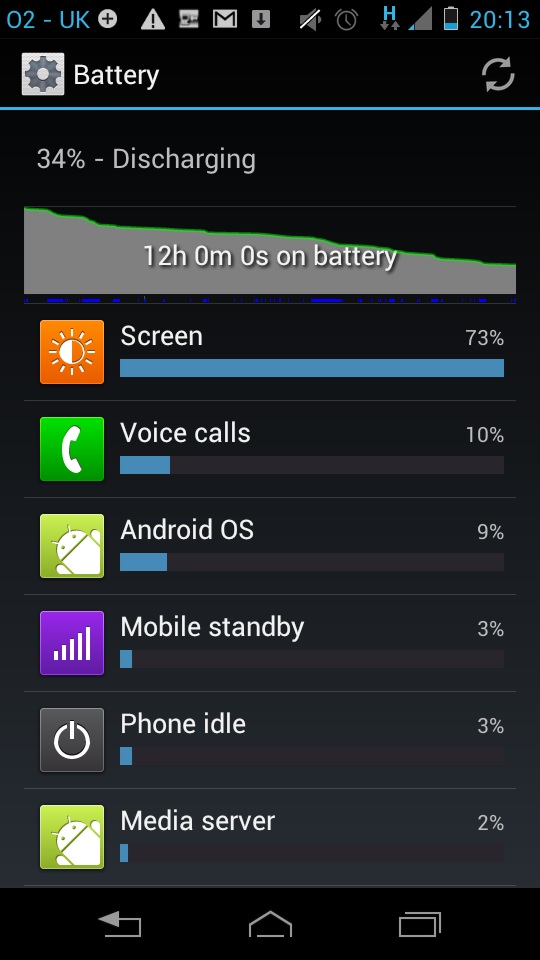Motorola Razr i review
The first Android phone to pack a 2GHz chip courtesy of Intel hits the market, but can it challenge the popular Galaxy S3 handset?
Motorola’s Razr i is a mid-range device, but it’s got a lot going for it: the best battery life we’ve ever seen, good performance thanks to an Intel processor, and good screen quality. The design, build quality and camera are good too, with the only black mark being an older version of Android and no firm timeframe for an update. If range-topping handsets are too expensive or too large, this 4.3in phone is an excellent alternative.

Battery life
We're willing to live with the slight performance issues though as the Razr i has stunning battery life the best result we've ever seen.
For our intensive battery test we set corporate email, Gmail, Facebook and Twitter accounts up to push content to the phone throughout the day, and we also carried out a range of tasks including browsing the web and watching a forty minute video. Brightness was cranked up to maximum, Wi-Fi turned off, and battery saving modes were also disabled.

Battery life is phenomenal - beating the best iOS and Android has to offer
Motorola's phone is the third handset to last beyond the 12 hour mark in our test, and it's the longest-lasting Ice Cream Sandwich device we've tested. After twelve hours the Razr i still well over a third of battery power remaining (34 per cent). This beat the Samsung Galaxy S3, which had 27 per cent remaining at 12 hours and left the iPhone 5 for dead as the Apple device ran out of juice completely after 10 hours.
Display
It's got good power and top-tier battery life, but the Razr i isn't as expensive as the priciest handsets. The screen is one area where the budget has obviously been cut: the 4.3in panel is physically smaller than the 4.8 screens included on other phones, and the resolution of 540 x 960 means the Motorola can't compete on a pixel-by-pixel basis, either - its 256ppi is no match for the 306ppi of the Samsung.
Pixels are visible if you look closely, but the Motorola redeems itself elsewhere. The AMOLED screen's brightness level of 219cd/m2 is reasonable, even if it can't match the 240cd/m2 of the Galaxy S3. That's partnered with the perfect contrast provided by the AMOLED panel, and it makes for a screen's punchy, with accurate colours.
The handset itself doesn't break much new ground, but build quality is good throughout, and its 8.3mm girth is 0.3mm thinner than the Samsung. The styling won't be to everyone's taste, with exposed screws and Kevlar backing lending the Razr i an industrial feel. Durability has been improved across the entire handset thanks to Motorola's water-repellant Splash-Guard coating, and this is one of the toughest Android handsets on the market.
Sign up today and you will receive a free copy of our Future Focus 2025 report - the leading guidance on AI, cybersecurity and other IT challenges as per 700+ senior executives
Mike Jennings has worked as a technology journalist for more than a decade and has been fascinated by computers since childhood, when he spent far too long building terrible websites. He loves desktop PCs, components, laptops and anything to do with the latest hardware.
Mike worked as a staff writer at PC Pro magazine in London for seven years, and during that time wrote for a variety of other tech titles, including Custom PC, Micro Mart and Computer Shopper. Since 2013, he’s been a freelance tech writer, and writes regularly for titles like Wired, TechRadar, Stuff, TechSpot, IT Pro, TrustedReviews and TechAdvisor. He still loves tech and covers everything from the latest business hardware and software to high-end gaming gear, and you’ll find him on plenty of sites writing reviews, features and guides on a vast range of topics.
You can email Mike at mike@mike-jennings.net, or find him on Twitter at @mikejjennings
-
 Trump's AI executive order could leave US in a 'regulatory vacuum'
Trump's AI executive order could leave US in a 'regulatory vacuum'News Citing a "patchwork of 50 different regulatory regimes" and "ideological bias", President Trump wants rules to be set at a federal level
By Emma Woollacott Published
-
 Microsoft Excel is still alive and kicking at 40 – and it's surging in popularity as 82% of finance professionals report ‘emotional attachment’ to the spreadsheet software
Microsoft Excel is still alive and kicking at 40 – and it's surging in popularity as 82% of finance professionals report ‘emotional attachment’ to the spreadsheet softwareNews A recent survey found Gen Z and Millennial finance professionals have a strong “emotional attachment” to Microsoft Excel
By Emma Woollacott Published
-
 LastPass hit with ICO fine after 2022 data breach exposed 1.6 million users – here’s how the incident unfolded
LastPass hit with ICO fine after 2022 data breach exposed 1.6 million users – here’s how the incident unfoldedNews The impact of the LastPass breach was felt by customers as late as December 2024
By Emma Woollacott Published
